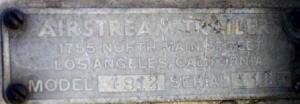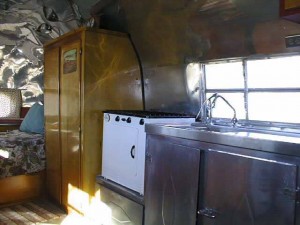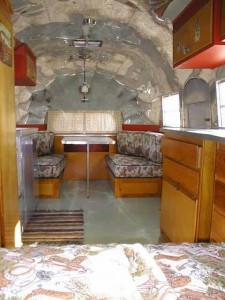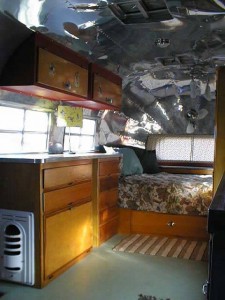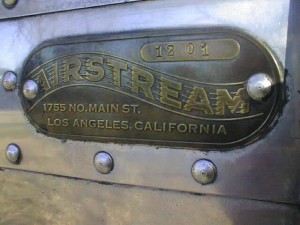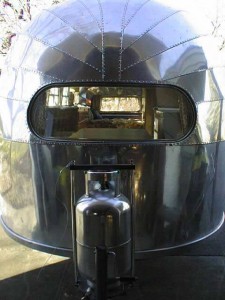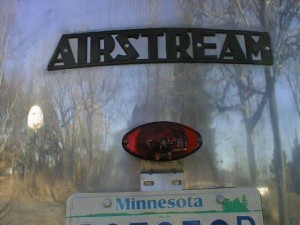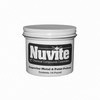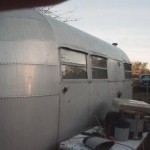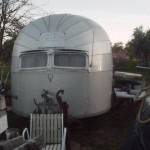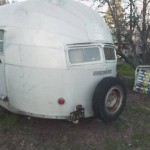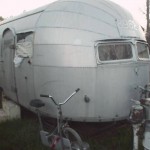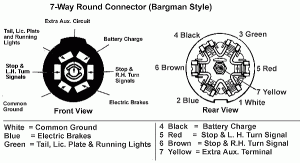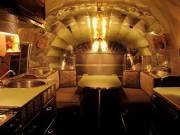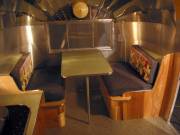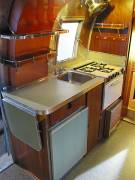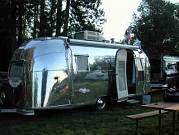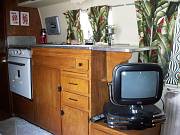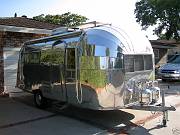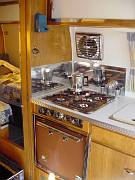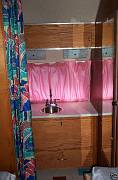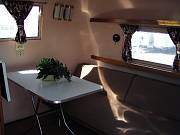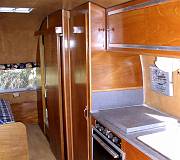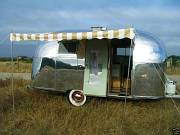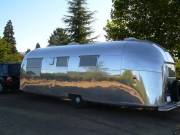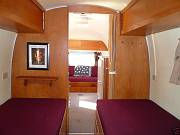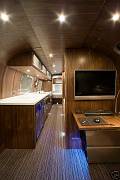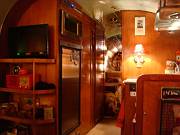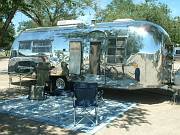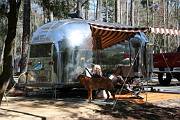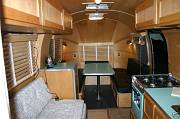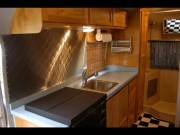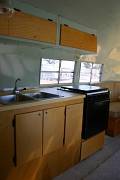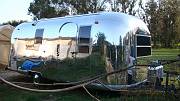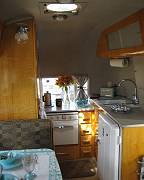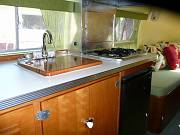Q: I’ve been told my trailer has “Split-Rims”, and the tire dealer won’t replace my tires on them. What are these split-rims?
A: Split rims are used to describe a style of wheel popular up until the early 1960’s. The wheel consisted of a 2 part ring on the outside rim of the wheel. This was to allow easy replacement of the tire and inner-tube. The only catch was that if the ring was not seated correctly, as the tire was inflated it could fly-off with explosive force, injuring the person standing over the wheel. There are special cages to inflate such wheels, but most shops just have a blanket policy of no split-rims. The fix is to replace the rims with new solid steel conventional wheels. Click on below images to enlarge. You can see the spit rim ring seam at the bottom of the wheels.
-
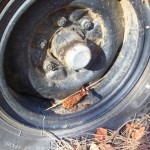
-
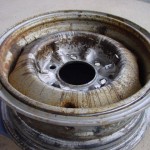
Q: What size wheels do I use to replace the split-rims?
A: The standard for all single axle Airstreams, except the Bambi, is a 15″x6″, zero offset with a 6 lug pattern on 5.5″ spacing, rated at 2600#. A properly rated Chevy truck wheel will meet this sizing, too. Don’t use underrated car wheels. The desired color for originality is a black wheel.
Q: My wheels are 14.5″ in diameter, but look original – are they?
A: They most likely are. Airstream offered the smaller diameter wheels as an option in the 1950’s for buyers with automobiles to match the lower hitch heights. Often called “low-riders” today, many folks swap these out with standard 15″ rims to gain a little more ground clearance, but here is nothing wrong with leaving them as is. Finding tires may be an issue though.
Q: My Airstream doesn’t have any hubcaps. Where can I get some?
A: Depends on your year trailer. If it still had the split-rims wheels, the moon style hubcap has spring-clip that slipped inside the wheel center – these are no longer available and are hard to find. If you have conventional wheels, the style up to 1971 was a baby moon style of hubcap. 15″ wheels use a 10 1/4″ ID and 14″ wheels use a 9 1/8″ ID style. You can find them at any utility trailer dealer or on eBay. The later style hubcaps show up on eBay all the time.
Q: I’m not sure of what size tire to get for my trailer, as it seems the original sized tires are not readily available. What should I do?
A: Best bet is to get the trailer to a dealer, provide them with as much information as you can, and let them match, mount and then install the tires. That way if there is an issue, they are responsible for making the tire fit. Generally, the tire used on the older trailers were 7.00 x 15 LT (Light Truck) 8 ply bias ply tires of the era. Some exceptions are the small 16 to 18 foot trailers, which used a 6.70 x 15 LT tire, as did some early tandem axle trailers.
ST type (special trailer) tires weren’t available back then – the same with radial tires. The ST has a stiffer sidewall than a passenger car radial and has UV inhibitors in it – not really an issue if you use the trailer at least 6 times a year to release the friction activated inhibitors, and protect the tires from the sun while in storage. Radials were used, usually the 225SR15 and 205SR15 sizes once they came out in the ’70’s. You can retrofit radials in some cases where clearance is not an issue, but it is recommended to use the ST type, as the average radial sidewall flexes too much when used on a trailer.
Q: What style are these axles on my trailer?
A: Until 1962, axles used on airstreams varied greatly, from the cast cross member leaf-spring “Model A” type axles of the ‘40’s and early ‘50’s, to the heavy duty leaf-spring tubular type specialized trailer axles of the mid and late ‘50’s, usually by Hadco. In 1961 Airstream introduced their own unique suspension assemblies which were called Dura-Torque. Later, the suspension manufacturing unit was sold along with the design and rights. It became Henschen Mfg, and is located in an old building several blocks from Airstream in Jackson Center.
This new design was a square tube (axle) with a smaller square steel shank with two 90 degree angles (suspension arm) inserted into the larger tube. Cushion and support is provided by four approximately 12″ long round rubber rods of approximately 1/2″ diameter inserted between the flat side of the suspension arm and the corners of the square axle tube. The rods are temporarily placed in a super cooling freezer beside the work station, using liquid nitrogen to shrink the rubber rods. The rods are quickly removed from the freezer, placed by a gloved hand against the suspension arm, and the arm with rods are shoved into the axle tube. The weight ratings of the Henschen Dura-Torque axles are determined by the diameter and hardness of the rubber rods. To this durable but smooth riding system, conventional shock absorbers are then added for additional ride dampening.
Q: Do these Dura-torques wear out?
A: Yes. The rubber rods eventually will take a set from their own weight and just sitting. High-mileage trailers, or those left out in the elements can suffer from deterioration of the rubber rods will wear out even faster. There isn’t any hard and fast rules. There are early ‘60’s trailers with plenty of spring left, and 1970’s trailers that are shot. When the ‘spring’ goes from these axles, going over bumps and pot-holes can result in the torsion arm coming up and hitting the stop there to prevent the wheel from contacting the wheel-well or the rubber rods from being displaced. This jolt and not only shake up your packing, but can weaken the frame and trailer structure and skin joints.
Q: How can you tell if the Dura-torque axle is worn-out?
A: This is going to vary depending on who you talk to. A good rule of thumb is that the trailing torsion arm shouldn’t be angled upwards past horizontal when the trailer is fully loaded. A good second opinion verification is to put masking tape or sealant on the up stop. If the stop gets hit during routine travel, you will be able to tell, and your axle is a candidate for replacement.
Q: You had a 1965 Axle break on your Caravel. Do you recommend replacing the Dura-torque Axle precautionary?
A: If you have a pre-1967 axle with non-tapered inner bearings, I would recommend replacing the axle. More info in this restoration topic section. Also, any axle older than ~1978 is going to have the rubber rods pretty much worn out and should be evaluated for replacing anyway.
Q: If I have to repair/replace my Dura-torque axle, what are my options?
A: Henschen no longer repairs the older Dura-Torque axles, replacement is the only solution (Airstream Dealer). For experienced restorers, you can spec out a new torsion axle from Dexter or Axis Products, but you cannot order, say “an axle for a 1968 Safari”. More info in this restoration topic section.
Q: What about the older leaf spring axles?
A: Here you have many more choices. The axle components can be replaced or repaired using conventional auto/trailer parts, such as leaf springs, brake drums and brake parts, shocks, hubs, bearings and wheels. If an axle is too far gone (rusted or broke) a new Dexter or Hadco axle can be attached, or a new torsion axle can be retrofitted. See this Restoration Resource section for alternatives and the replacement we did on our Flying Cloud.
Q: The small 13 inch wheels on my Bambi are not split-rims, but the hub caps are no longer available, what can I do?
A: These wheels were actually low cost 4-lug Ford Mustang/Falcon wheels of the era. Replacements are usually made using Dexter wheels and moon hub caps just like the bigger trailers. As an option, you can usually go up to 14” wheels and use P185/75R14 tires and have just enough wheel-well clearance.
Q: What if can’t find parts for my small Bambi axle?
A: Replace the axle with one from Dexter. The old axles have a 10″ brake drum with 4 bolts. That pattern is no longer available. Use the 10″ drum with 5 bolts and get the new Dexter matching wheels and Moon hubcaps. The new axle actually fits the frame better than the old one. Installation only requires that new holes be drilled in the frame rail. The new install is actually cleaner than the old one.
Q: What is a Pipe Frame” Airstream?
A: “Pipe frame” Airstream trailers were built from 1947 to 1950, and usually have both or one end rounded with a single wide oval window on that rounded end. Travel trailers back then were built very light with few appliances and furnishings, so their frame could be relatively lightweight. The pipe frame was strengthened slightly in 1949 by adding another 3′ section of pipe inside the front most 3 feet near the hitch. But the frame soon became insufficient for the added weight of larger trailers with more stuff installed and loaded inside.
The “pipe frame” was also called a “Centerpole” by Airstream. The frame is like a fish skeleton: a longitudinal center rib with outriggers to both sides. The outriggers are not all that strong and cannot take too much weight being placed on them, other than above the wheels, which has some additional framing to attach the axle. You will typically see the appliances mounted in the center of trailers, usually above or just forward of the wheels, as that is best for weight distribution. If the small brackets that secure them to the centerpole become detached, you can (it has been done!) pull the centerpole right out the front of the trailer.
The first ladder frame Airstream with a “A” frame up front appeared in mid 1949. It was the 24′ “Unlimited”, soon to be renamed the “Cruiser.” By late 1950, all new Airstream trailers were built using the ladder frame.
The pipe frames are still OK if not rusted inside the tube, the outriggers have not become detached, if the trailer is kept light and not overloaded, and if you avoid using weight equalizing bars. To see what a Pipe-Frame looks like, check this ’48 Liner page.
Q: My leaf-spring axle has hydraulic brakes, can these still be used?
A: More than likely the axle was made by Hadco Engineering, a supplier to Airstream in the 1950’s. You can either maintain the brakes as hydraulic, which can be done with the use of a hydraulic actuator mounted somewhere on the trailer, or you can replace the axle. Both hydraulic and electrical components are still available from Hadco. The old Stromberg slave cylinder, parts and fittings are not made anymore, though. Hydraulic actuators are available from Carlisle.
Q: What is “rear end sag” or droop?
A: It is a chassis to shell separation on longer Airstreams, usually Ambassadors and Sovereigns prior to 1982. It was caused by the installation of gray (1973+) and black water tanks, along with the battery and weight of the bathroom fixtures in the back end of these long trailers. This combined weight, especially when the trailer was towed with the tanks left full, caused the shell to separate from the frame in the back from all the dynamic flexing, and ultimately bent the frame just aft of the wheel wells.
The fix is to install Airstream bulletin #29. It consists of two perforated plates, notched and pre-drilled to fit over the axles on both sides. You need to go through an Airstream dealer or authorized repair service to have the work done. If the shell is detached from the frame or the frame is bent, that will have to be corrected also. The bulletin is in the VAC Online Library if you wish to see if the mod has been done to your trailer. Ways to recognize the condition is to stand on the bumper and see if the frame moves and the shell doesn’t. Other sure signs are loose interior partitions and cabinets, or a 45 deg bulge in the side of the skin just aft of the wheels.
It can occur on other models of trailers, but is usually caused by the floor rotting in the rear of the trailer, and the C Channel that attached the upper and belly skins to the wood floor coming loose from the floor.
Q: What is the best way to replace the old worn electric brake parts? How often do I need to grease the wheel bearings?
A: Use a loaded backing plate, replacing the entire brake assy at each wheel. It consists of the magnet, brake shoes, springs, etc. mounted on the “backing plate”. There are several advantages to loaded backing plates. Often the cost of the individual components meets or exceed the cost of the complete unit. The process for replacement is: undo the 5 (or 4) bolts and two wires. Reinstall, connect wires, which do not need to be connected in any certain way, reinstall hub/drum and adjust. You’re done. You will now have all new springs, brake shoes and a current style magnet.
It also makes sense to repack the wheel bearings at the same time. A tip for removing the grease seal. Pry off the dust cap, cut and remove the cotter pin, remove the castle nut and washer, remove the outer bearing, replace the washer and nut, pull the hub/drum toward you allowing the washer to bear against the inner bearing, pulling with a sharp movement nearly always dislodges the inner bearing and seal with no damage to the bearing. Pack the bearings per this Champion article.
Another area that you need to be aware of are the different grease seals available. Many RV outlets have a simple single lip seal that will fit in Airstream axles. Airstream does not use nor do they recommend the use of single lip seals. Their recommendation is to use double lip seals only. They may be a little harder to find is a small price to pay for the added security.
The original P/N was a National 291148 felt seal and 292100 in the ‘60s Henschen axle. The 292100’s are available from OasisRV. The TCM 21325TB is a good substitute for the 291148. It is a double lip seal, also.
Q: What shocks should I use?
A: Except for later model tandem axles, conventional heavy-duty auto and light truck shocks are correct. Take a shock to an auto parts store so they can match the ends, stroke & length.
With the big body style change in 1969, Airstream changed to a horizontal mounted (trailing arm) shock absorber configuration. They can also be found on some later ’60’s dual axles.
What makes the new shock special is: “The shock used in the horizontal mount is a specialty shock built for Airstream by Gabriel. The difference is a bladder is used to hold the oil on the piston. The typical design of shocks would allow the oil to pool away from the piston leading to premature failure.” This shock is the one you need to get from Airstream dealers. While a conventional shock can be made to fit, you can see it may eventually fail.
Q: How do you carry a spare tire?
A: Either in the tow vehicle, under the bed if you have an external access compartment, or by one of these ideas:
http://www.airmarktools.net/services/airstream-parts/index.html
https://vintageairstream.com/photo-archives/1959-world-traveler-22/ (This was original from Airstream)
https://vintageairstream.com/1965-caravel-index/after-tour/#details This last one was made from C channel used to hang ceilings in commercial buildings, and was bought in 1965 (commercial made) from the Airstream dealer.
Q: Are two axles better than one?
A:Depends. Modern trailers usually always have 2 for a couple of reasons. Manufactures can use 2 lower cost, lighter weight axles, wheels & tires than the more expensive heavy duty single axles. 2 axles are more stable and the trailer tracks straighter. A tire blowout can result in a easier to manage condition, you can even remove a blown tire and proceed slowly on the remaining tire to a service station. The downside? You have 2 of everything. Twice the cost of maintenance – tires need to be replaced every 7-8 years, bearings repacked every 3 years. When fixing up an older trailer you may have to replace the axles – again twice the cost. Single axle trailers are more maneuverable and have more interior storage (less wheelwell size). As you can see, there is no clear answer.
